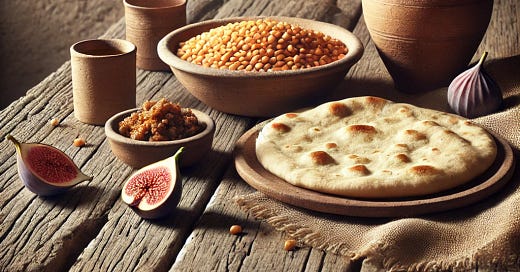I once read about an academic study of changing eating habits. The “data” used by the study consisted of artistic depictions from the past thousand years of festive meals. The study authors estimated the caloric value of the portions displayed from era to era and concluded that the average meal size had, through the centuries, been steadily and remarkably growing.
Well we Jews have our own data source that might help us track changing eating habits. The Gemara (Kesuvos 64b) lists the minimum food a husband living apart from his wife is expected to provide each week:
2 kav of wheat
1/2 log of olive oil
1/2 kav of beans
1 kav of figs
The fact that, a thousand years later, the Tur (Even Haezer 70) codified those numbers suggests that they made sense in his generation, too. If we can figure out how much actual food those amounts represent, we should have a sense for what has or hasn’t changed over time.
First of all, the Gemara records a debate between R’ Shimon and R’ Yochanan ben Beroka over the amount of wheat needed for a basic meal. R’ Shimon teaches that a meal requires 1/9 of a kav, and R’ Yochanan ben Beroka (according to R’ Chisda, at least) puts it at 1/8 of a kav. We’ll go with that latter opinion here. Therefore, the necessary volume of wheat for one day (assuming two meals/day) would equal 1/4 kav. The surplus wheat from each week (above and beyond her own 14 meals) permits a wife to share some food with guests.
Historical estimates of the volume measure of one kav range between 1.2 and 2.4 liters. In terms of weight, that would be somewhere between 712 and 1,423 grams of wheat. That would come to between 178 and 355 grams for each day of the week.
A liquid log measure probably lies somewhere between 300 and 600 ml. Our typical wife’s daily ration of olive oil would therefore fall between 21 and 43 ml. She’d also get between 51 and 101 grams of beans and between 101 and 202 grams of figs.
The lower estimated total caloric value of her daily diet would therefore be around 931 calories, and the higher estimate would be double that (1,862).
We should remember that the Gemara’s volume requirements are meant to be minimums; they’re aimed at the very poorest of Jewish couples. The average Jew might well have eaten considerably more. But this is a useful indication of how little food was necessary for survival. For comparison, the modern minimum healthy daily caloric intake for an adult woman will, depending on how active she is, vary between 1,200 and 2,200 calories.
Have our basic physical needs changed over the centuries? Possibly. Although perhaps not nearly as much as some people might think.





The gulag punishment ration was 300 grams a day (from Kolyma Tales, Varlam Sharlamov), which usually led to slow death by starvation.